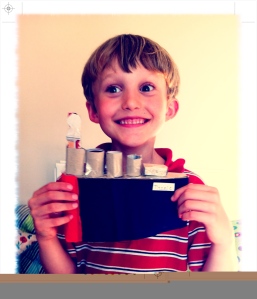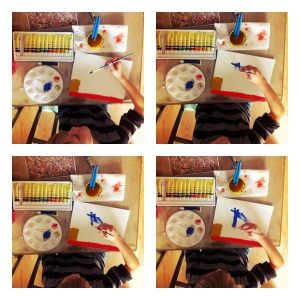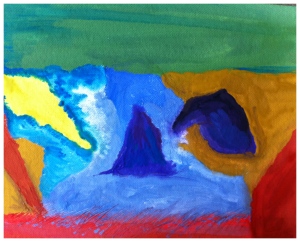Ingredients: Boxes and tubes of all shapes and sizes, bottle tops, bubble wrap, polystyrene, drinking straws, inner chocolate box packaging, some spray paints (kept out of child’s reach), stickers in all colours, winged pins, string / ribbon, different types of sticky tape (sellotape, masking tape, electrical tape, parcel tape), glues (PVA and Pritt stick), a tool that punches holes easily, possibly even a Makedo set, good quality scissors. All kept in an accessible replenishable box.
The Big Sell: Build me something the world has never seen!
Strategy: All parents do it – the roll of the eyes as you present your child with a rather expensive new Christmas present and they fling it to one side and spend the rest of the day playing with the large cardboard box. But what’s really going on here?
Children have an innate ability to be explorers – they haven’t yet learnt to be afraid of the act of creation (linking it to failure and disappointment as many of us do as we grow older). They often don’t want to be told what ‘should’ be fun (by an adult toymaker) but reject conformity to discover the world for themselves. If only we didn’t grow out of that state?!
If I were to choose one activity that has taken up 75% of my sons’ childhood so far, it would be the act of junk-modelling. And I believe it is seriously underrated as a lazy past time, an end of the day ‘that’ll occupy them for a few minutes’ second rate, cheapskate distraction before we get stressed by the mess and it’s tidied away.
But I think it is so much more. When I take a moment to watch my eldest at work with junk he is using so many skills – developing his maths by taking accurate measurements and creating symmetry; learning engineering by constructing strong platforms, pulleys, hinges, catapults; exploring critical and imaginative thinking by breaking down big dreams into the small steps towards realisation. He is also learning social skills – managing his expectations of what is achievable in a given time frame and with limited resources, recycling the useless into the useful, even demonstrating love by creating birthday presents (like a ‘tea-maker’ for me) when he has no access to bought things, and communicating his end product by providing a showcase. If I were to describe his best talents within the framework of his school curriculum, they would fall under ‘Science’ and ‘Visual arts’ – truly a Leonardo da Vinci of the junk-modelled world.
If you have a little inventor in your home, as well as supplying them with endless refuelling of interesting objects to occupy their minds and fingers, you can also encourage them with these challenges for Advanced Junk Modelling Fun:
- The Transformer junk model – make something that turns from one object into another? (See Transformer Robot model above).
- The Moving junk model vehicle – wheeled, flying, hovercraft (using semi-inflated balloons), floating (see Titanic model above – historically accurate as it really did sink!)
- The Stage Set junk model – one previous effort was Harry Potter’s Chamber of Secrets complete with Chess set, Devils Snare (green wool), cardboard roll sewer tunnels, flying keys (hanging from thread). (The picture above is my son’s Harry Potter ‘Hogsmead’ stage set with working elevator).
- The Garden Orchestra junk model – use old metal tubes, cans (with the edges sanded smooth), tins and pans with wooden drumsticks to make music outside.
- The Marble Run junk model – weave all your old cardboard tubes into a taped maze.
- The Make Do and Mend junk model – teach them about World War II and the impact of rationing on children’s experiences – invite them to invent a toy to take on an ‘evacuated’ journey (to a pretend Bunker den in the garden).
- And of course, the Den junk model – reinvent the largest cardboard boxes you can find into an igloo / treehouse / teepee / other assorted living space of child’s choice.
The verdict: A junk modelling child is one that is following an ‘enquiry-based’ model of education, in which rather than memorising and recalling a set of facts they learn to form and test a hypothesis, use the world around them to spark an idea, pursue an ideal and visualise a transformation. A junk modelling child learns that truly creative practice can be explosive in terms of the unanticipated outcome, and that’s more exciting than any old bit of plastic from the shops.
Catchphrase: “Can I email the toy-making people, Mum, to show them my prototype for a real Harry Potter Hogsmead Play-set?”
Left wanting more?
- Inspirational role models include the Honda Cog Video – a favourite for any age. Alternatively watch Caratacus Potts from Chitty Chitty Bang Bang for his breakfast baking machine.
- Another fabulous recycled idea I spotted the other day was DNA Puppetry’s Shadow Suitcases for homemade travelling puppet theatres.








